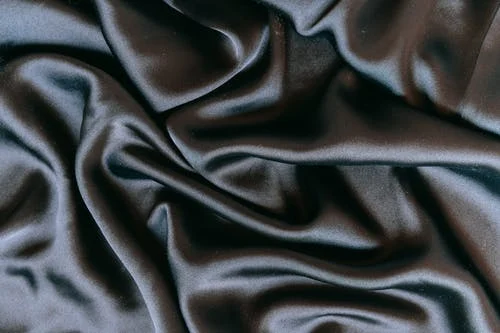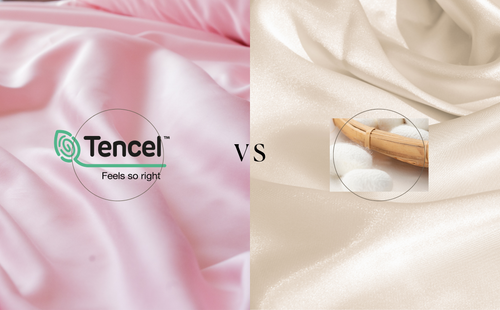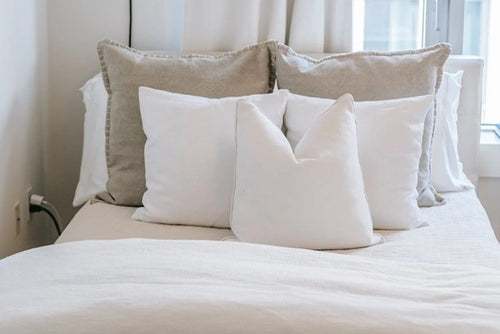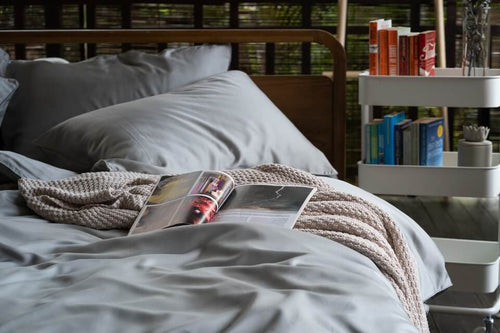At a Glance
While silk undoubtedly offers a luxurious sleeping experience, it comes with a significant cost - in terms of price and ecological impact. Here are eco-friendly alternatives to consider!
Quick Tips
- Beyond the texture, discover how a high-quality product is made.
- Some eco-friendly materials can offer the same quality without breaking the bank.

Image by Antoni Shkraba from Pexels
TENCEL™: The Socially Responsible Vegan Silk
Silk has long been associated with luxury. Its gentle and soft feel makes it a favourite for items closest to us, such as undergarments, pyjamas, and bedding for sensitive skin. In a warm, humid climate, a silk bed sheet in Singapore sounds like a dream. Everyone wants a piece of the luxe life - after a long day, we all deserve to rest like a king.
But while silk makes for a luxurious night’s sleep, it comes at a cost. From rearing silkworm larvae to waiting for their week-long cocoons to finish, it takes months and thousands of resources just to create just a pound of silk.
Not only is silk tedious to extract, but also harms lives. The only way to extract silk without ruining the integrity of the fibres is to boil the cocoons - killing the larvae in the process. With the rise of environmental consciousness and veganism, using silk has become a hard pill to swallow. Vegans believe that all animals - including worms - should live in peace.
Alternatively, there are plenty of other bedding materials that can provide you a similar level of comfort as silk bed sheets that hold a luxury status as well. Refer to our how to choose bed sheets guide to find the ideal bedding material for you.
For avid fans of silk fabrics, thanks to modern technology, there are other ways to indulge in silk without guilt. From TENCEL™ bed sheets to Spider silk jackets, check out these vegan silk options and how they hold up as a socially responsible fabric of the future:
The Classics

Image by Madison Inouye from Pexels
Ramie
Derived from the stalks of a flowering plant in the nettle family, Ramie is commonly used in China, Brazil, and Thailand. This fibre-based vegan silk has been depended on for its strength, especially when wet. It has a texture similar to linen that is able to resist wrinkling which makes for excellent clothes that hold its shape. The material is also naturally antibacterial and relatively easy to dye.
Cupro
Cupro is a recycled, plant-based fabric made out of linter - small cotton fibres that were too small to spin by cotton production standards. These are collected, dissolved in a solution, and spun into fibre. The material feels like silk and drapes like it too. It is also easier to maintain as the fabric is machine washable. Niche designers have already started designing with this fabric - from a silk pillowcase to an eye mask.
Material rating: 1/3 - Ramie and Cupro are natural materials that have been harnessed for fabrics for hundreds of years. However, both show points for improvement as top-tier materials. Ramie’s physical properties make for a brittle material on its own. It requires blending with cotton or synthetic materials which are not necessarily sustainable to achieve the desired softness and elasticity to keep up with our needs. Meanwhile, Cupro’s processing methods include harmful chemicals such as ammonia and caustic soda which wreak havoc on the environment.
The Current

Featuring Weavve’s TENCEL™ Bed Sheets Classic Set Blush Pink
TENCEL™ Lyocell Fibres
As the most unnatural word on the list, many might be wondering - what is TENCEL™? Invested by the Austrian company Lenzing, TENCEL™ Lyocell fibres are made from the wood pulp of lush eucalyptus trees, soaked in an easily recoverable solvent, and dried through a spinning process. The resulting material has a good structure on its own and is biodegradable and low-maintenance. TENCEL™ is very absorbent while also resistant to bacterial growth, which makes for the perfect all-around material that is socially responsible and ecologically sustainable.
TENCEL™ can be used in varying thicknesses and textures for garments. It is also growing increasingly common to find TENCEL™ bed sheets, TENCEL™ duvets, and TENCEL™ pillowcases.
Bamboo Fibres
Bamboo fabric is made by turning bamboo sheets into pulp through a chemical or mechanical process, then spun and woven into cloth. Known as Bamboo rayon or Bamboo viscose, the fabric is smooth to the skin, while bamboo’s antifungal properties protect the wearer from bacteria and allergies. Its durable yet flexible chemical makeup lends well to fabric, producing clothes that are weather-proof - breathable, moisture-wicking in all climates, and machine washable. The accessibility of Bamboo in Asia makes this material affordable - so you can rest your head on a silk pillowcase at a fraction of the cost.
Material rating: 3/3 - Both TENCEL™ and Bamboo are eco-friendly products that are flexible to demanding needs. Despite having less of the shimmer that silk provides, both materials more than make up for it by being naturally antibacterial, hypoallergenic, breathable, and moisture repellent. With its low cost, Bamboo bed sheets are a favourite for anyone who wants to take their sleep seriously for less. Plus points go to TENCEL™ fibres for its closed-loop production process, making it the most vegan and sustainable option.
The Future

Image by Sunsetoned from Pexels
Orange silk
Orange Silk is - you guessed it - fabric powered by orange peels. Using patented technology, Italian entrepreneurs Adriana Santanocino and Enrica Areno extracted the cellulose material from discarded orange peels and spun this into orange yarn. The resulting material is shiny and soft, resistant to wrinkling, and easily blended with other types of fabric. It also drapes beautifully, making for a versatile fashion material - Salvatore Ferragamo and H&M have capsule collections powered by Orange Silk.
Microsilk
Ever had dreams of becoming Spider-Man? That technology has yet to exist, but wearing a spidey suit might just be within reach. US-based company Bolt Threads harnessed the strengths of spiders and created genetically engineered spider silk. No spiders are involved in the making of Microsilk - it is only composed of synthetic genes, yeast, sugar, and water. The mix is then left to ferment into a soft yet durable yarn. It has been used by designers such as Stella McCartney and is developing partnerships with outdoor wear brands such as North Face.
Material rating: 2/3 - Designers have started testing on Orange Silk and Microsilk fabrics and vouch for their versatility. But while these are viable fabrics of the future, the two have yet to reach critical mass to assess their sustainability in scale. However, a close-up look at their production process shows that both products are cruelty-free and utilise natural materials and processes. Props to Orange Silk for turning trash into treasure in using fruit waste as its key ingredient.

Image by Isabelle Taylor from Pexels
Conclusion
A variety of vegan silk options are within reach - a combination of natural and engineered ones for the future. These alternative materials deliver the same luxurious experience of silk while also providing added features to provide comfort, safety, and even improved health.
Material ratings for current vegan silks are the best because of their ability to address long-term needs with accessible solutions. In Singapore, TENCEL™ bed sheets and Bamboo sustainably sourced garments are excellent materials to solve discomforts brought by warm climates and delicate skin conditions.
But beyond the material, it’s now just as important to know how a high-quality product is made. Whether classic, current, or future, vegan silks only have one goal: being a fabric that cares for all - for you, the animals, and the environment. You can rest on your vegan silk bed sheets and know that you’ve done your part in making the world a better place.
Isn’t that a great way for natural silk to finally retire?
TENCEL™ Lyocell Sheets
 Featuring Weavve’s TENCEL™ Bed Sheets Deluxe Set Midnight Blue
Featuring Weavve’s TENCEL™ Bed Sheets Deluxe Set Midnight Blue
Weavve's TENCEL™ Lyocell Sheets are made with the best TENCEL™ Lyocell fibres that are spun into the finest 80s yarn count threads. These sheets are silky smooth and temperature regulating, making them perfect for areas with high temperatures. These fine single ply threads are then woven into a 400 thread count fabric, which allows your skin to dissipate heat easily, ensuring that you sleep cool and uninterrupted through the night.
Shop TENCEL™ Bed Sheets Singapore
TENCEL™️ Lyocell Duvet
 Featuring Weavve’s Lyocell Duvet + Lyocell Duvet Cover
Featuring Weavve’s Lyocell Duvet + Lyocell Duvet Cover
Weavve’s duvet is the first duvet in Singapore featuring 100% TENCEL™ Lyocell fibres in both its exterior fabric and inner filling, providing you with great thermal regulation properties for maximum comfort and rest.
We designed this duvet to help everyone sleep better through the night, regardless of the varying temperatures so that you can wake up feeling at your best everyday.
When constructing our TENCEL™ Duvet, we ensured that we considered all aspects to give you the optimal comfort and best sleep experience. It is lightweight compared to quilts, perfect for tropical weather and temperature regulating.





































